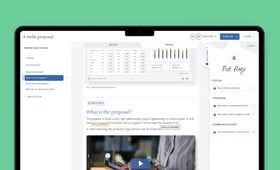A board meeting has three main goals: oversight, accountability, and decision-making. Effective board meetings help members better understand performance and make timely, informed decisions. This happens through productive discussion, healthy challenge, and focusing directors' time and experience on what matters most.
However, that’s easier said than done. Unstructured agendas, unprepared members, and poor timekeeping can derail meetings. Harvard research found that only 64% of directors rate their board discussions as high quality.
This guide covers running effective board meetings, building strategic agendas, managing time, building consensus, and tracking meeting quality.
Pre-meeting planning and preparation
Running a good board meeting starts with preparation. Guidance from Deloitte suggests boards should consider “doing more to be prepared and engaged”, proactively gathering insights both from management and their own research and outreach.
Board members need to balance what must get done with the time they have. This starts before they take a seat at the boardroom table and the meeting begins. Clear objectives, planning strategic agendas, and high-quality information will help ensure directors arrive prepared.
Setting clear objectives
Boards and executive teams share a mission but have different roles and very different day-to-day responsibilities. Boards guide long-term strategy and governance, while executive teams implement organizational strategy and handle day-to-day operations.
To deliver against these responsibilities and ensure focus and alignment within and across the board and executive committee, the corporate strategy and goals, and the board and executive team’s respective mandates should be clearly defined and well understood by all involved.
This makes it easier to plan forward calendars and meeting agendas that serve the right purpose.
Creating strategic agendas
A clear agenda is essential when time is short and to-do lists are long. Chairs, CEOs, and company secretaries should set structured agendas in advance.
Each agenda item (and the meeting overall) should have a clear objective. Strike a balance between strategy and oversight.
Research by Board Intelligence and Cambridge Judge Business School found that boards spend only 32% of meeting time on strategy, and half of directors are unhappy with that balance.
The best agendas prioritize strategy over routine updates. Tools such as Board Intelligence’s Six Conversations Model help spread focus across strategy, performance, and governance.
You can also use tools like our Agenda Planner to streamline agenda creation and make last-minute changes easier.
High-quality board papers
Research by Board Intelligence and the Chartered Governance Institute UK & Ireland shows board packs are getting longer, less useful, and costlier to produce, despite 85% of companies now providing management with board reporting training and templates. This suggests that, for many companies, templates and training aren’t working, and their investment in board reporting isn't paying off.
To raise the quality of your board and management papers:
- Align the executive team and board around what a good board paper looks like and provide consistent feedback to produce better reports.
- Brief report writers well to prevent time-consuming rewrites.
- A clear executive summary for each report is needed, to put key messages up front.
- Use templates to map out the high-level questions for writers to answer and give them a structure to follow.
You can use the Question Driven Insight Principle to help guide writers and stay focused. Tools like Lucia, our AI-powered writing assistant, give instant feedback to help deliver reports that are concise, forward-looking, and relevant. Our Board Reporting Assessment tool, used together with the Board Reporting Calculator, will show you what value you're getting from your board papers.
High-quality data visualization
Board papers must be clear and insightful. Provide short summaries of key metrics, trends, and decisions.
A high-quality KPI dashboard provides a visual summary of performance and outlook, helping directors grasp the big picture at a glance.
Pre-reading requirements
Best practice dictates that directors should get board packs at least one week in advance. However, our research shows that 55% receive them (often running over 200 pages) less than five days before meetings.
Late delivery makes it tough for directors to prepare. Share information early so they can review and reflect in advance without getting overwhelmed.
Meeting structure and flow
The chair should ensure the meeting follows the agenda. t helps to balance your agenda thoughtfully, limiting board administration and performance reviews to no more than 25% of your meeting time.
Focus most time on two to three high-value topics like investments, strategy, or market shifts. Tackle these early in the meeting while directors are alert.
Guide management on what information needs to be included to make these board discussions productive.
Time management strategies
The gap between what boards need to accomplish and the time they have is growing. Our recent survey found that a striking 91% of business leaders want their boards to cut down on irrelevant discussions and focus more on the organization’s big-picture visions and goals.
Breaking the agenda into time blocks helps to keep the meeting on track.
Ask directors to review materials and submit questions before the meeting for clarity. This lets management prepare solid answers and keeps meetings focused on objectives. Chairs should also talk with directors ahead of time to flag major issues that might require discussion.
Discussion facilitation
Running effective board meetings demands clear communication, staying on topic, and making space for all voices.
Ask open-ended questions like, "What are the biggest risks in this proposal?" or “What other options have you considered?”. This will spark more discussion and wider participation.
Encourage quieter voices and manage dominant ones. A “round-robin” method — where each person shares their view in turn — can help balance input and ultimately enhance the decision-making process.
Decision-making process
A board’s value hinges on how well it makes decisions. Research with chairs shows that 43% of the reasons for poor decisions were related to either missing or poorly structured information.
Top causes of weak decision-making:
- Information gaps
- Cognitive bias
- Unclear or long-winded materials
- Dominant voices
- Lack of time.
Fixes include improving the decision papers that summarize management’s analysis and recommendations, spending time with employees or external stakeholders, and asking questions ahead of time. Board members also need strong critical thinking skills to spot bias, ask tough questions, and explore all sides of an issue while avoiding groupthink.
Strategic focus
Staying strategic is hard, but nevertheless essential. Strategy decisions pave the mid- and long-term path of the business and are shaped by the company’s mission, vision, and objectives.
These decisions don’t need exact plans, just clear objectives for management to act on.
Building consensus
While often overlooked, an important facet of effective board meetings is building consensus, especially on major strategy calls.
This means working in good faith to meet shared goals and the interests of all stakeholders. Done right, it reflects a range of views and avoids groupthink. Decisions that reflect diverse experiences and viewpoints are the hallmarks of successful consensus-building.
Critical thinking supports this by encouraging objectivity and open debate.
Post-meeting actions
Track follow-ups to stay accountable. Steps include finalising and distributing meeting minutes, compiling documentation of decisions, and listing follow-up action items such as assigning responsibilities, setting deadlines, and communicating key decisions to relevant stakeholders.
Make sure management follows through and report on progress at the next meeting. Gathering feedback will improve future board discussions and decision-making processes. This will help enhance board effectiveness overall.
Follow-up and documentation
Writing minutes takes time. On average, governance teams spend 10 hours per meeting. This comes at a real cost. Use our minutes calculator to uncover what the hidden cost is for your organization.
Board Intelligence’s Minute Writer lets you turn notes and transcripts into clear, structured meeting minutes in mere moments. It’s a secure, purpose-built AI tool that’s designed by board experts.
Progress monitoring
It’s best practice to regularly review how meetings, papers, and processes are working, as part of a board effectiveness review.
Use our Board Reporting Assessment tool to track progress on the quality of your board information and meetings, or consult the Board Intelligence team for a bespoke board pack diagnostic.
Board portal software often includes analytics tools that can help you track board performance and engagement. It can generate insights around meeting attendance and document access. Data like this shows what’s working and where to improve.
FAQs
What is the optimal length for a board meeting?
Two to three hours works best. This duration is long enough for depth but short enough to avoid fatigue. Shorter meetings can work if pre-reads are sent in advance. Boards may also have regular performance update calls in between quarterly strategic board meetings.
How far in advance should board papers be distributed?
At least one week. This gives directors time to prepare and review key information. Timely distribution improves engagement and ensures that discussions are more strategic and action-oriented.
How can we ensure balanced participation from all board members?
Create an open environment and culture of inclusivity. Invite quiet voices to share. Manage the dominant ones. Anonymous feedback tools or note-sharing can also help board members share their insights freely.



